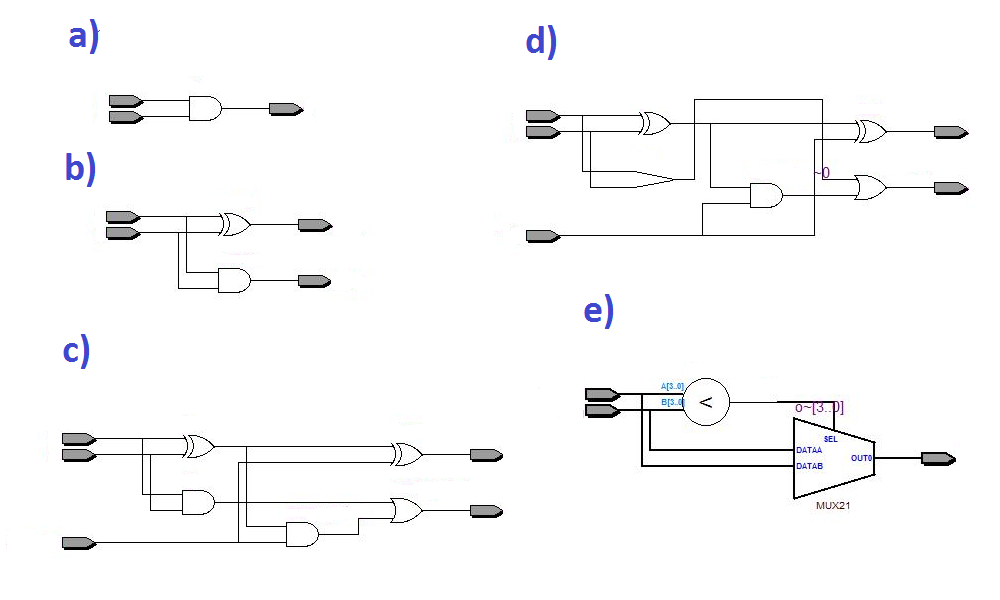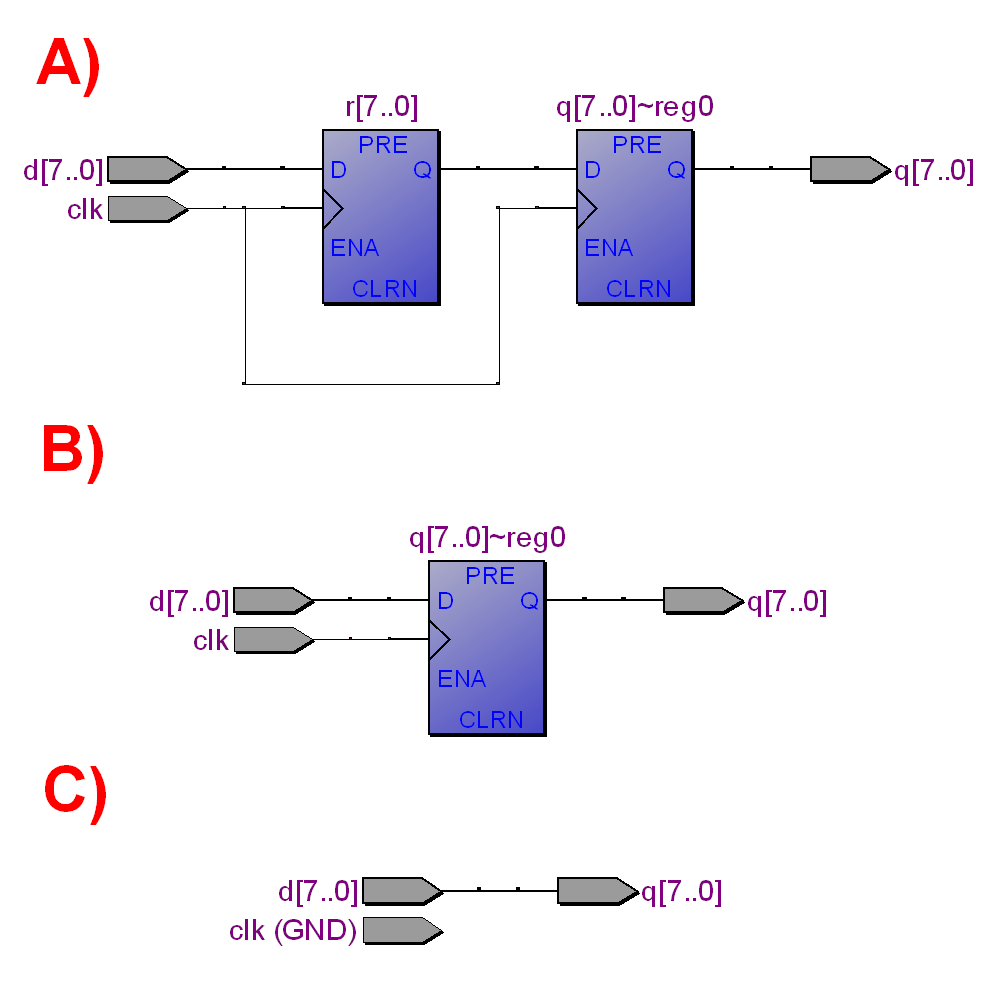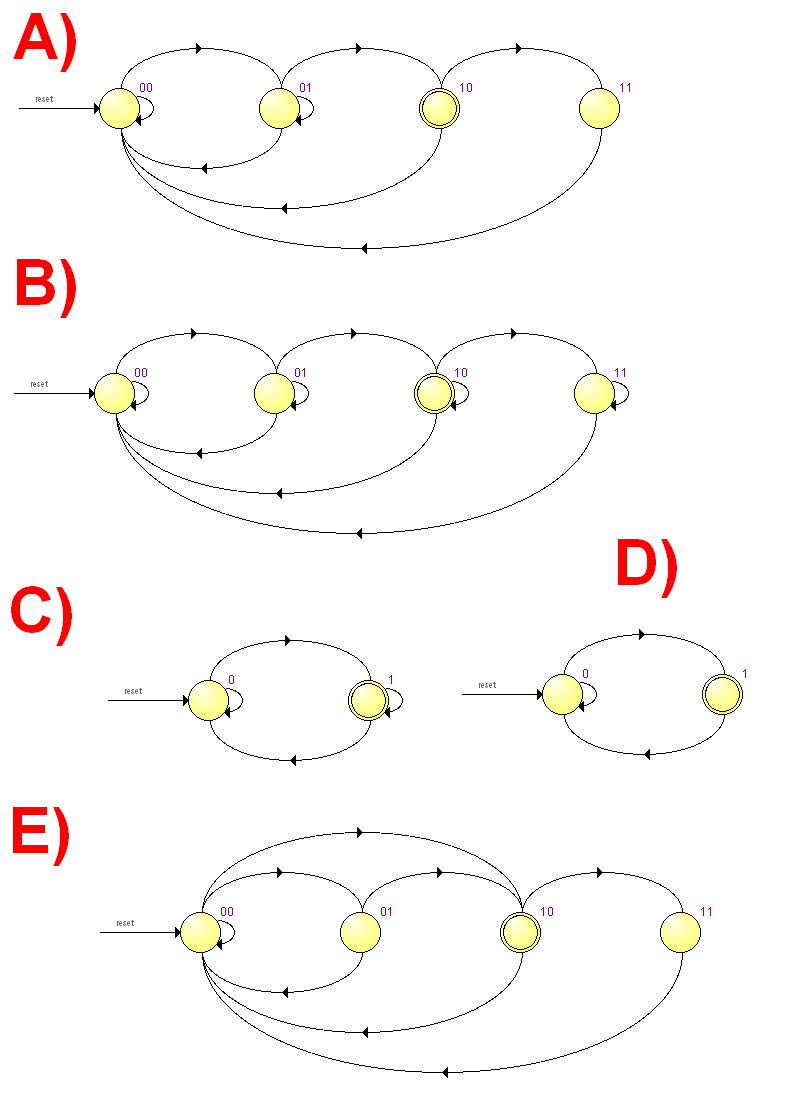 b)
b)
 c)
c)
 d)
d)
 e)
e)
 2. What is the result of synthesis of this module?
module design
(
input a,
input b,
input carry_in,
output sum,
output carry_out
);
wire p = a ^ b;
wire q = a & b;
assign sum = p ^ carry_in;
assign carry_out = q | (p & carry_in);
endmodule
2. What is the result of synthesis of this module?
module design
(
input a,
input b,
input carry_in,
output sum,
output carry_out
);
wire p = a ^ b;
wire q = a & b;
assign sum = p ^ carry_in;
assign carry_out = q | (p & carry_in);
endmodule
 3. Which waveform is the simulation result of Verilog code below?
module dut
(
input clk,
input [7:0] d,
output logic [7:0] q
);
always @(posedge clk)
q <= d;
endmodule
module testbench;
logic clk;
logic [7:0] d, q;
dut dut (clk, d, q);
initial
begin
clk = 0;
forever
end
initial
begin
$dumpvars ();
for (int i = 0; i < 10; i++)
begin
@(posedge clk);
d = i;
end
$finish;
end
endmodule
a)
3. Which waveform is the simulation result of Verilog code below?
module dut
(
input clk,
input [7:0] d,
output logic [7:0] q
);
always @(posedge clk)
q <= d;
endmodule
module testbench;
logic clk;
logic [7:0] d, q;
dut dut (clk, d, q);
initial
begin
clk = 0;
forever
end
initial
begin
$dumpvars ();
for (int i = 0; i < 10; i++)
begin
@(posedge clk);
d = i;
end
$finish;
end
endmodule
a)
 b)
b)
 c)
c)
 4. What schematics correspond to Verilog code below?
module dut
(
input clk,
input [7:0] d,
output logic [7:0] q
);
logic [7:0] r;
always @(posedge clk)
r <= d;
always @(posedge clk)
q <= r;
endmodule
4. What schematics correspond to Verilog code below?
module dut
(
input clk,
input [7:0] d,
output logic [7:0] q
);
logic [7:0] r;
always @(posedge clk)
r <= d;
always @(posedge clk)
q <= r;
endmodule
 5. What Finite State Machine (FSM) state diagram correspond to Verilog code below?
module dut
(
input clk,
input resetn,
input a,
output b
);
logic [1:0] state;
always @(posedge clk)
if (! resetn)
state <= 0;
else
case (state)
0: if ( a) state <= 1;
1: if (! a) state <= 2;
2: state <= 3;
3: state <= 0;
endcase
assign b = (state == 2);
endmodule
5. What Finite State Machine (FSM) state diagram correspond to Verilog code below?
module dut
(
input clk,
input resetn,
input a,
output b
);
logic [1:0] state;
always @(posedge clk)
if (! resetn)
state <= 0;
else
case (state)
0: if ( a) state <= 1;
1: if (! a) state <= 2;
2: state <= 3;
3: state <= 0;
endcase
assign b = (state == 2);
endmodule

The code below contains three modules implementing the same functionality, calculating the power of five of a given number. Analyze the code and answer the following questions: module pow_5_implementation_1 ( input clock, input [17:0] n, output reg [17:0] n_pow_5 ); reg [17:0] n_1, n_2, n_3; reg [17:0] n_pow_2, n_pow_3, n_pow_4; always @(posedge clock) begin n_1 <= n; n_2 <= n_1; n_3 <= n_2; n_pow_2 <= n * n; n_pow_3 <= n_pow_2 * n_1; n_pow_4 <= n_pow_3 * n_2; n_pow_5 <= n_pow_4 * n_3; end endmodule //-------------------------------------------------------------------- module pow_5_implementation_2 ( input [17:0] n, output [17:0] n_pow_5 ); assign n_pow_5 = n * n * n * n * n; endmodule //-------------------------------------------------------------------- module pow_5_implementation_3 ( input clock, input reset_n, input run, input [17:0] n, output ready, output [17:0] n_pow_5 ); reg [4:0] shift; always @(posedge clock or negedge reset_n) if (! reset_n) shift <= 0; else if (run) shift <= 5'b10000; else shift <= shift >> 1; assign ready = shift [0]; reg [17:0] r_n, mul; always @(posedge clock) if (run) begin r_n <= n; mul <= n; end else begin mul <= mul * r_n; end assign n_pow_5 = mul; endmodule
6. Which implementation is purely combinational? a) pow_5_implementation_1 b) pow_5_implementation_2 c) pow_5_implementation_3 d) pow_5_implementation_1 and pow_5_implementation_2 e) pow_5_implementation_1 and pow_5_implementation_3 f) pow_5_implementation_2 and pow_5_implementation_3 g) all of them h) none of them
7. Which implementation is sequential? a) pow_5_implementation_1 b) pow_5_implementation_2 c) pow_5_implementation_3 d) pow_5_implementation_1 and pow_5_implementation_2 e) pow_5_implementation_1 and pow_5_implementation_3 f) pow_5_implementation_2 and pow_5_implementation_3 g) all of them h) none of them
8. Which implementation is pipelined? a) pow_5_implementation_1 b) pow_5_implementation_2 c) pow_5_implementation_3 d) pow_5_implementation_1 and pow_5_implementation_2 e) pow_5_implementation_1 and pow_5_implementation_3 f) pow_5_implementation_2 and pow_5_implementation_3 g) all of them h) none of them
9. Identify the implementation that corresponds to the following schematics: a) pow_5_implementation_1 b) pow_5_implementation_2 c) pow_5_implementation_3 d) pow_5_implementation_1 and pow_5_implementation_2 e) pow_5_implementation_1 and pow_5_implementation_3 f) pow_5_implementation_2 and pow_5_implementation_3 g) all of them h) none of them
10. Identify the implementation that corresponds to the following schematics: a) pow_5_implementation_1 b) pow_5_implementation_2 c) pow_5_implementation_3 d) pow_5_implementation_1 and pow_5_implementation_2 e) pow_5_implementation_1 and pow_5_implementation_3 f) pow_5_implementation_2 and pow_5_implementation_3 g) all of them h) none of them
11. Identify the implementation that corresponds to the following schematics: a) pow_5_implementation_1 b) pow_5_implementation_2 c) pow_5_implementation_3 d) pow_5_implementation_1 and pow_5_implementation_2 e) pow_5_implementation_1 and pow_5_implementation_3 f) pow_5_implementation_2 and pow_5_implementation_3 g) all of them h) none of them
12. Which implementation is likely to allow the highest maximum frequency (assuming that the outputs of the combinational implementation are connected to clocked register)? a) pow_5_implementation_1 b) pow_5_implementation_2 c) pow_5_implementation_3
13. Which implementation is likely to use the smallest number of gates? a) pow_5_implementation_1 b) pow_5_implementation_2 c) pow_5_implementation_3
14. Which implementation is likely to have the highest throughput (number of calculated pow_5(n) results per seconds)? a) pow_5_implementation_1 b) pow_5_implementation_2 c) pow_5_implementation_3
15. Which implementation is going to have the smallest latency in clock cycles (assuming that the outputs of the combinational implementation are connected to clocked registers)? a) pow_5_implementation_1 b) pow_5_implementation_2 c) pow_5_implementation_3
16. The testbench instantiated all three implementations of pow_5. module testbench; reg clock; reg reset_n; reg run; reg [17:0] n; wire ready; wire [17:0] n_pow_5_implementation_1; wire [17:0] n_pow_5_implementation_2; wire [17:0] n_pow_5_implementation_3; initial begin clock = 1; forever # 50 clock = ! clock; end initial begin repeat (2) @(posedge clock); reset_n <= 0; repeat (2) @(posedge clock); reset_n <= 1; end pow_5_implementation_1 pow_5_implementation_1 (clock, n, n_pow_5_implementation_1); pow_5_implementation_2 pow_5_implementation_2 (n, n_pow_5_implementation_2); pow_5_implementation_3 pow_5_implementation_3 (clock, reset_n, run, n, ready, n_pow_5_implementation_3); integer i; initial begin $dumpvars; $monitor ("clock %b reset_n %b n %d comb %d seq %d run %b ready %b pipe %d", clock, reset_n, n, n_pow_5_implementation_1, n_pow_5_implementation_2, run, ready, n_pow_5_implementation_3); @(posedge reset_n); @(posedge clock); for (i = 0; i < 50; i = i + 1) begin n <= i & 7; run <= (i == 0 || ready); @(posedge clock); end $finish; end endmodule
An engineer simulated the testbench and got the following waveform. However he forgot the order he added the last three signals to the waveform. Can you determine which signal is the output of combinational implementation, sequential non-pipelined implementation and sequential pipelined implementation? a) The order is (from upper n_pow_5... to lower n_pow_5...): combinational, sequential non-pipelined implementation, pipelined b) combinational, pipelined, sequential non-pipelined implementation c) pipelined, combinational, sequential non-pipelined implementation d) pipelined, sequential non-pipelined implementation, combinational e) sequential non-pipelined implementation, combinational, pipelined f) sequential non-pipelined implementation, pipelined, combinational
Exam is created by Yuri Panchul with some code borrowing from Digital Design and Computer Architecture, Second Edition by David Harris and Sarah Harris, 2012